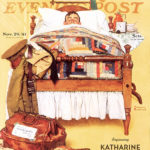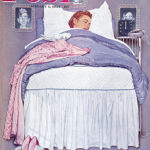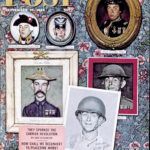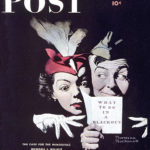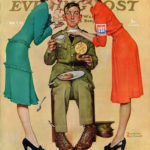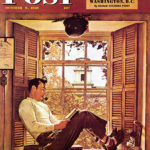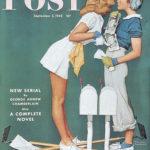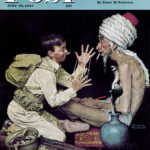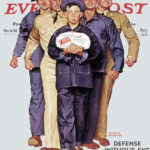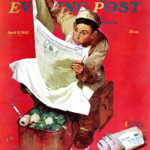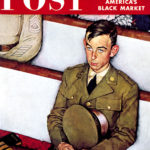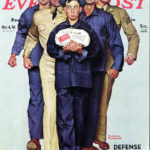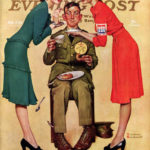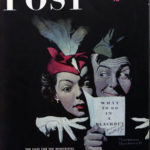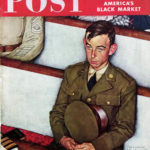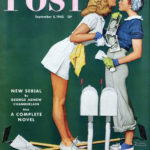The Rockwell Files: Willie Gillis Comes Home
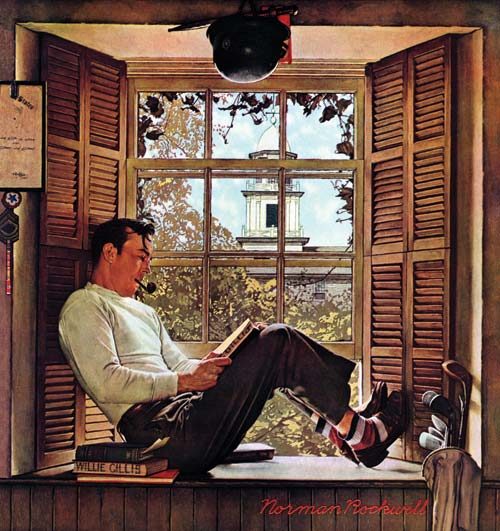
© SEPS
When Norman Rockwell chose to portray a typical American draftee in 1941, he created the character Willie Gillis, using the features of a local boy, Robert Buck. The beloved anti-hero — Willie was never portrayed in battle and seemed more a passive victim of circumstance than a warrior — disappeared from the Post’s cover during the last year of the war. It was no mystery: Buck was off serving in the South Pacific, and Rockwell refused to portray Willie in action without his model.
Willie’s reappearance, shown here, was as a civilian. Post readers would have recognized that Willie, like 7 million other veterans, was off to college, taking advantage of the G.I. Bill. Along with the stacked textbooks and nearby golf clubs, Rockwell acknowledged the experience that helped shape veterans like Willie. Trophies from the German foe appear on the wall above the window. Behind him, Willie proudly hung his framed discharge papers. He also tacked up his Army service patch, master sergeant’s insignia, and campaign ribbons. Some day they would share a place of honor in Willie’s home alongside his college diploma.
This article is featured in the May/June 2017 issue of The Saturday Evening Post. Subscribe to the magazine for more art, inspiring stories, fiction, humor, and features from our archives.
A Salute to Veterans
Tributes to the military have long been portrayed on covers of The Saturday Evening Post, from situations serious to humorous. In honor of Veterans Day, we would like to share some of our favorites.
The first Post military cover? An action depiction of U.S. soldiers on horseback in the Philippines.
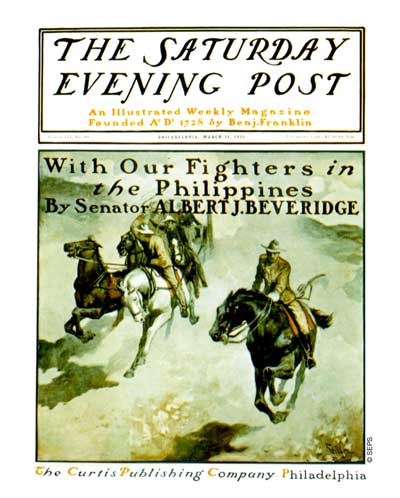
George Gibbs
March 31, 1900
He’s in the Army now. A seldom seen cover from December 1942 by John Atherton shows a faithful dog and a photo. From the uniform, we can guess where its master is. We hope he returns home soon – Spot is itching to go hunting.
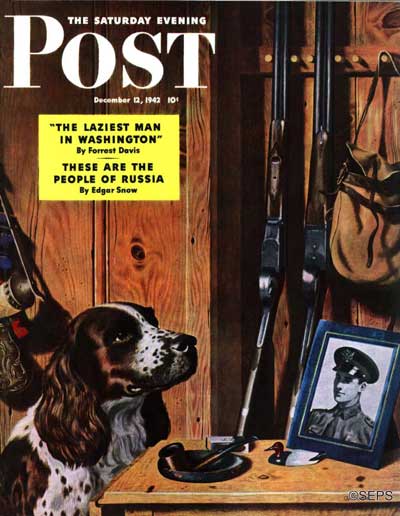
John Atherton
December 12, 1942
The enlisted also included members of the Women’s Army Corps (WAC), as shown in the cover from 1942 by an artist named Gilbert Bundy.
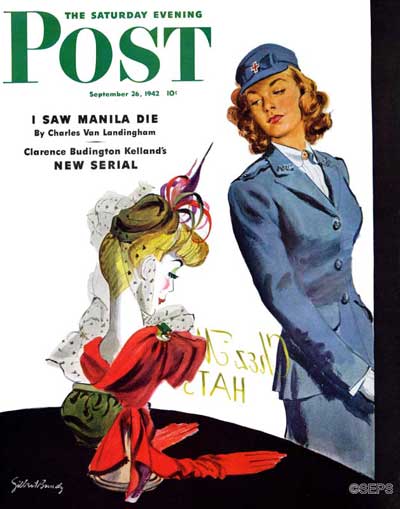
Gilbert Bundy
September 26, 1942
A WWI soldier shares a humble Christmas meal in this endearing 1917 cover by the prolific J.C. Leyendecker.
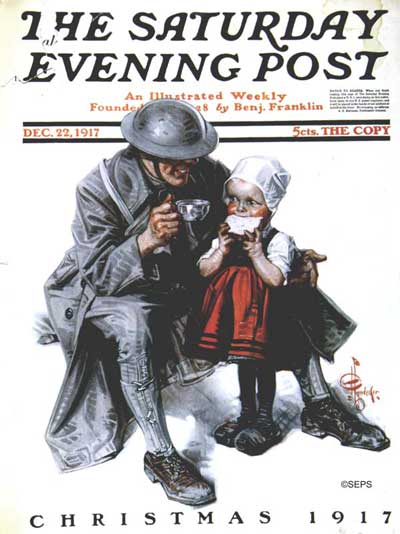
J. C. Leyendecker
December 22, 1917
On the May 14, 1927, cover by E.M. Jackson, this sailor accomplishes an important mission overseas — finding a genuine American hot dog!
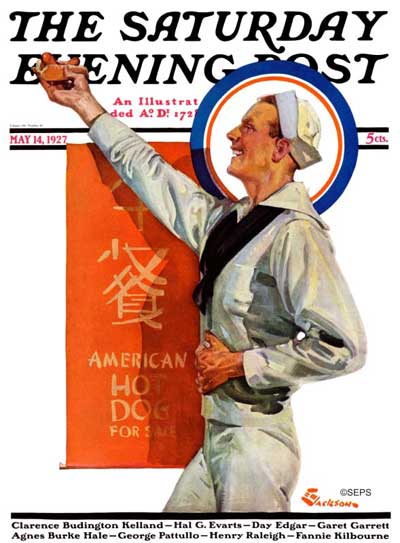
E.M. Jackson
May 14, 1927
Celebrating soldiers, sailors, and marines, the 1937 cover by John Sheridan captures all three with a parade below in their honor.
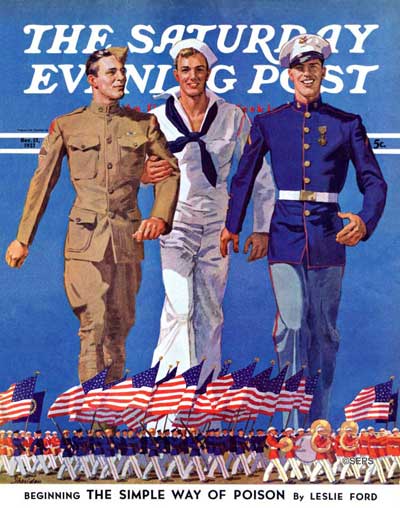
John Sheridan
November 13, 1937
Norman Rockwell honored the military during the WWII years with several covers of the “every soldier” he named Willie Gillis. We’ve shown Willie’s military adventures before, but not this one from 1941. Rockwell’s famous private is home on leave, snuggled under the quilts and enjoying the luxury of sleeping late. The sign above the bed echoes our ardent wish for all our military men and women: Home Sweet Home.
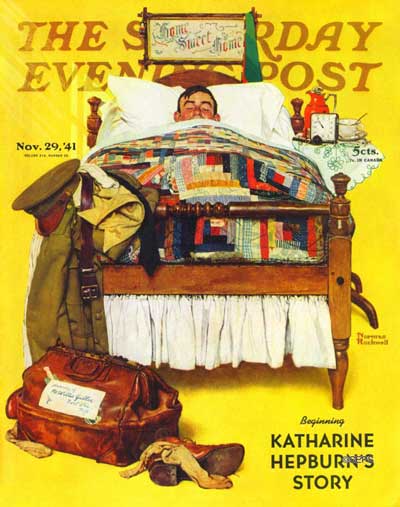
Norman Rockwell
November 29, 1941
After Forest Gump, actor Gary Sinise became an advocate for wounded soldiers. Check out Jeanne Wolf’s interview with Sinise from the September/October 2014 issue here.
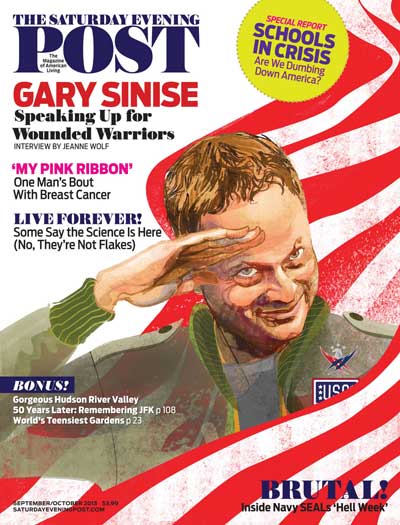
John Jay Cabuay
September/October 2014
Thanks, Robert Buck. Goodbye, Willie Gillis.
We were saddened this week to hear of the death of Robert Otis Buck.
The name may not be familiar to you, but the face should be. Norman Rockwell chose it for his Willie Gillis series, which portrayed events from the life of a young American GI.
Willie first appeared on the cover of the Post on October 4, 1941. When he next appeared, a year later, the editors ran this short item:
There have been so many questions about the first Willie Gillis cover by Norman Rockwell that we’re glad to supply a few answers. No, Willie is not a soldier. He works in a sawmill near Mr. Rockwell’s Vermont home.
And that was all they said about Mr. Buck.
Over the next two years, Willie Gillis had adorned the Post cover eight times and had become a celebrity. Like Rosie the Riveter and the Americans shown in the Four Freedoms, he had become a symbol of the American war effort. He had become so popular, the Post finally divulged the model’s identity.
Willie in real life is Robert Otis Buck, known to his friends as “Little Buck.” Norman Rockwell, seeking a model for his Willie Gillis Post covers, spotted Little Buck in the summer of 1941 at a square dance at Arlington, Vermont, where the Rockwells live.
“Norman stared at the boy so long,” Mrs. Rockwell said afterward, “that Buck was ready to take a poke at him until Norman finally explained that he wanted him for a model.”
The following June Little Buck was graduated from Salem Washington Academy, Salem, New York, and went to work for General Electric at Pittsfield, Mass. Mr. Rockwell made a number of sketches of Little Buck for future Willie Gillis covers.
Rockwell liked Buck’s looks. He wasn’t glamorous. He didn’t exude bravery and nobility. To Rockwell, the character of Willie Gillis was “an inoffensive, ordinary little guy thrown into the chaos of war.” He would look decent and unsophisticated, but ready to adapt to life in the Army.
Rockwell also liked the fact that Buck had a medical deferment, which kept him out of the draft, so his model would be available for posing throughout the war. But by 1943, Robert Buck was tired of sitting out the war.
The trouble with the country and the world, too, is that nothing stays put. Not even Pvt. Willie Gillis.
We hope your illusions are good sturdy fellows, able to take it on the chin when we report, as we feel bound to do, that Gillis is leading a double life—has been since May, when he joined the Navy.
On May fourteenth, Buck entered the Navy as apprentice seaman at the Naval Training Station at Sampson, New York. The following day the Rockwell studio at Arlington burned and all [of Rockwell’s sketches of Buck] were destroyed. The Navy, with the generous realization that life must go on for Pvt. Willie Gillis, lent him back to Mr. Rockwell long enough for the artist to make new sketches.
Little Buck, who, the Rockwells agree, is a swell youngster, hopes to become a Naval flying cadet at the end of eight months’ training.
He himself sees no impropriety in his up and joining the Navy after becoming, as Willie Gillis in Army togs, America’s No. 1 pin-up boy. As for his reason, it was simple. ” I just liked the Navy better,” he said.
Well, it’s Willie Gillis’, excuse us—Little Buck’s, young life to lead and to offer to whatever branch of the service he prefers. We’ve always rooted for the Annapolis football team ourselves. But all the same, Willie’s turning up in the Navy does underline the instability these days of all so-called established things.
In all, Buck/Gillis appeared on 11 Post covers. The last one showed him as a young man, discharged from the Army, studying at college. The American soldier was now the American scholar, one of 7.8 million Americans taking advantage of the G.I. Bill.
It was as happy an ending as Rockwell could have painted for the war. He gave the original painting to Buck, who never parted with it.
Norman Rockwell
November 29, 1941
Norman Rockwell
January 1, 1944
Norman Rockwell
September 16, 1944
Norman Rockwell
Jun 27, 1942
Norman Rockwell
February 7 , 1942
Norman Rockwell
October 5 ,1946
Norman Rockwell
September 5, 1942
Norman Rockwell
June 26, 1943
Norman Rockwell
October 4, 1941
Norman Rockwell
April 11, 1942
Norman Rockwell
July 25, 1942
Classic Covers: The All-American Soldier Willie Gillis
“Willie Gillis in Church” by Norman Rockwell
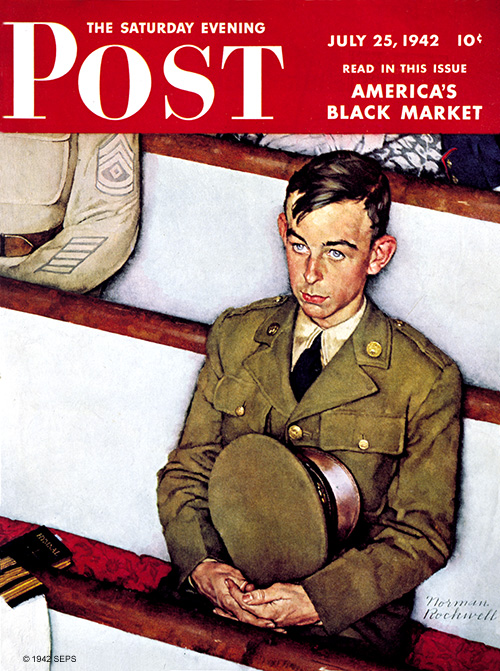
Norman Rockwell
July 25, 1942
This Memorial Day, we remember Norman Rockwell’s WWII soldier, Robert Buck, who passed away May 22, 2011, with warmth and gratitude.
“Willie Gillis on KP” by Norman Rockwell
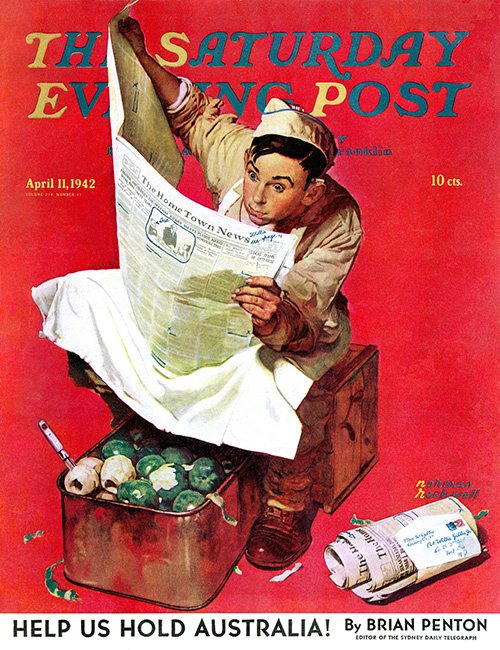
Norman Rockwell
April 11, 1942
Most artists depicted the WWII soldier as a big, strapping man with chiseled features. Rockwell wanted the boy next door. So he studied faces. “The model Rockwell used for Gillis was my wife’s uncle,” emailed Jarrod. “Apparently, they met in Vermont. He (Bob Buck) said that this guy wouldn’t stop staring at him and that he was about to knock his block off when the guy said he was Norman Rockwell and that he wanted to paint him.” By the time of this 1942 cover, many a soldier could identify with the homesick Willie eager for news from home. The war meant financial strains and spiraling costs for everything: it was with this issue that the price of The Saturday Evening Post rose from five to ten cents.
“Willie Gillis’ Package from Home” by Norman Rockwell

Norman Rockwell
October 4, 1941
Robert Buck said he was sixteen when he first posed for Rockwell, and both model and artist were surprised at the success of the Willie Gillis covers. This is the first of eleven covers of the “every soldier.” Nothing like a package from home to make you a popular guy. “Norman was a kind gentleman to work with,” Buck wrote. “I had no experience or training for modeling. Many poses or expressions had to be held for agonizing periods of time. Norman’s patience was terrific.” It sounds like the model showed great patience as well.
“Willie Travels” by Norman Rockwell
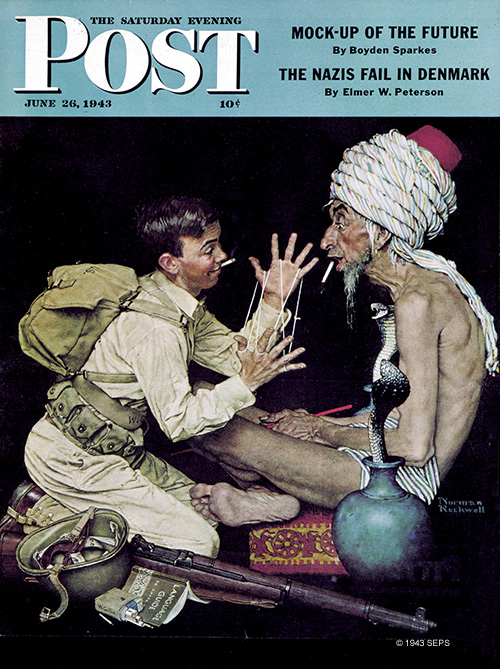
Norman Rockwell
June 26, 1943
This eighth cover from 1943 is ironic: A fakir with the power to charm cobras is astonished at Willie’s string trick. Looks like the small-town boy made it to the Middle East and possessed some charm himself. Rockwell was crushed when his “soldier” joined a branch of the Navy, leaving him without the model for his popular series. Ah, but Norman was clever, as we will see.
“Double Trouble for Willie Gillis” by Norman Rockwell
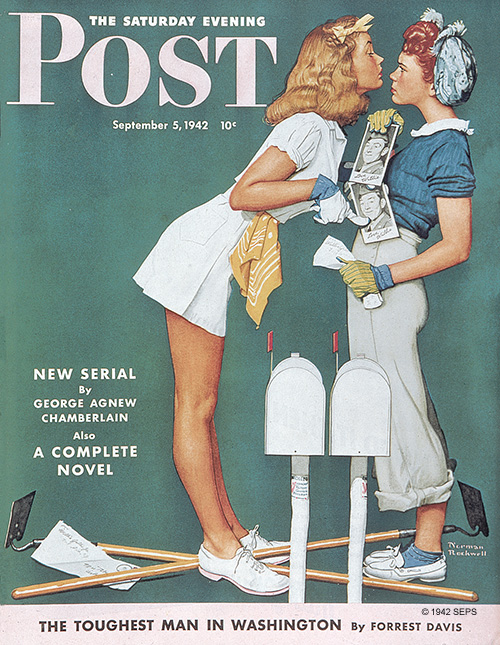
Norman Rockwell
September 5, 1942
When two young ladies check their mail at the same time, the result is trouble. Both have photos of our favorite soldier and each is signed, “Love, Willie.” Maybe you should stay in the war zones where it’s safe, Willie. This shows how smart Rockwell was to create another Gillis cover, using only a photo of Willie. It also shows how handy it was to have a good friend and neighbor like Post artist Mead Schaeffer, who happened to have a couple of pretty daughters to pose for the cover.
“Willie Gillis in College” by Norman Rockwell
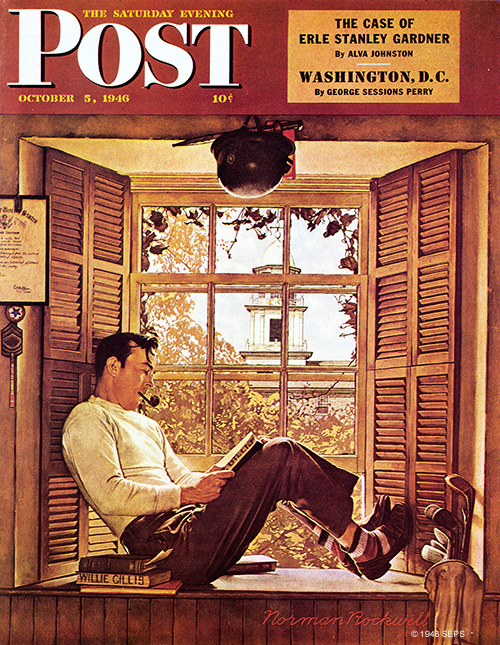
Norman Rockwell
October 5 ,1946
The final Gillis cover was in October 1946. Our favorite soldier, looking different in civvies, is using his G.I. Bill of Rights to attend college. After finishing this cover in Vermont, Rockwell enlisted the aid of his model to haul the painting to the Saturday Evening Post offices in Philadelphia, where Bob Buck was treated like a celebrity. Mr. Buck, soldiers from different generations will identify with these portraits of military life. Rest in peace, Bob.
Rockwell’s Willie Gillis
The Every Soldier
Two lovely ladies are at their mailboxes, but the situation isn’t pretty. Seems both have been communicating with the same soldier, Willie Gillis. Not the first time we find Willie in hot water.
Norman Rockwell created Willie Gillis as a kind of “every soldier,” not a strong-jawed, strapping hero, but a young man who, although in uniform, pretty much resembled the kid next door. This is perhaps most apparent in the July 25, 1942 cover showing Willie sitting in church. Alone in the pew, as far as we can see, he looks reverential and vulnerable. We like this kid.
But he did seem to have a way with the ladies. The February 7, 1942 cover shows Willie being plied with goodies from not one, but two attentive USO workers. The June 27 cover of the same year shows the soldier and a lovely lass reviewing an official booklet entitled What To Do in a Blackout. Willie appears to have some thoughts on the subject.
The first cover that featured Willie was October 4, 1941. Willie received a package from home labeled “FOOD.” He is looking over his shoulder, closely trailed by a half dozen eager soldiers. And it would appear they all outrank Willie.
Much is known about the iconic Norman Rockwell, a prolific illustrator whose name has become synonymous with The Saturday Evening Post. And we think he would be pleased to turn over Willie Gillis to us to salute all of our men and women in the Armed Forces. Brave, highly competent, and dedicated, they are also, as Norman Rockwell knew and captured in his illustrations, completely human.
